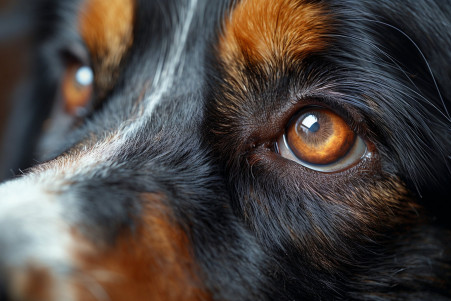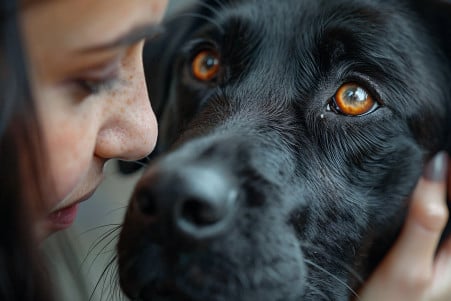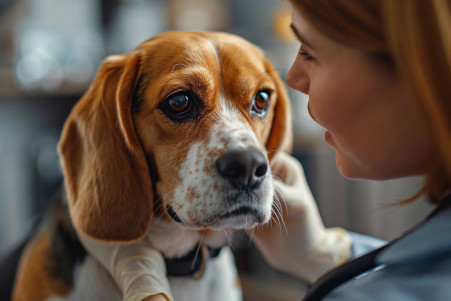Dog Styes: Causes, Symptoms, and Treatment
4 April 2024 • Updated 3 April 2024

If you’ve noticed red, swollen lumps on your dog’s eyelids or near their eyes, they may have styes, a common condition in dogs. But what causes styes, and how can you get rid of them? Styes, or hordeolum, in dogs are pus-filled lumps that form when the oil glands in the eyelids or the hair follicles near the eyes become infected with bacteria. Although styes can be painful for dogs, they’re usually nothing to worry about and can be treated at home with warm compresses and medication from your vet.
This article takes a deep dive into veterinary research and interviews with veterinary ophthalmologists to find out what causes styes in dogs, what the symptoms are, and the most effective ways to treat them. By the end of this evidence-based article, you’ll know everything you need to know to recognize, address, and even prevent styes in your dog.
Can dogs get styes?
Causes and Risk Factors of Dog Styes
Dog styes are most often caused by an overgrowth of bacteria, particularly Staphylococcus bacteria, in the oil glands or hair follicles around the eye. However, there are several other potential causes. Bacterial overgrowth can occur when oil glands become clogged and are unable to drain properly, which allows bacteria to grow and leads to a stye. Ingrown eyelashes that rub against the eye area can also introduce bacteria. Dogs with weakened immune systems are less able to fight off bacterial infections that may result in styes.
There are several risk factors that can make a dog more likely to develop a stye. Dogs with allergies that cause excessive eye irritation and inflammation are more likely to develop styes. Bacterial infections can occur after eye trauma, such as an injury or foreign object in the eye. Poor hygiene and the presence of dirt, debris, or excessive tear staining around the eyes can also increase the risk.
Some dog breeds may be more likely to develop styes due to their facial anatomy. Dogs with bulging, prominent eyes like Pugs or excessive skin folds around the eyes like Shar-Peis have a harder time keeping the area around their eyes clean, which makes them more likely to develop styes. It's important to identify and treat any underlying causes to prevent the recurrence of painful styes that can affect a dog's vision and quality of life.
Signs of Dog Eye Styes
A dog eye stye is a red, swollen bump on the eyelid or around the eye. Great Pet Care explains that this painful condition is caused by a bacterial infection in the oil glands or hair follicles. In addition to the bump, other signs of a stye include eye discharge, watery eyes, and the dog squinting or rubbing the eye.
Dogs may also shy away from having their eyes touched because of the pain caused by a stye. The Merck Veterinary Manual warns that styes can be mistaken for other eyelid issues like chalazions (which are clogged glands but not infected) or even eyelid tumors. It's important to recognize and treat a stye quickly to help the dog feel better and avoid complications.
Home Remedies and First Aid for Dog Styes
As noted by Cuteness, warm compresses can be used to help the stye drain and reduce swelling. The site suggests using chamomile tea bags or warm rice packs to help the area feel better. Wag! also recommends wiping the eye with a sterile saline solution or dog-safe eye wash to get rid of any discharge or debris.
Although you may find that over-the-counter antibiotic ointments or eye drops help, it's important to talk to a vet before giving your dog any medication, as noted by Cuteness. Do not try to pop or squeeze the stye, as this can make the infection worse and lead to more pain.
It's important to keep an eye on the stye and make sure to see a vet if your dog's symptoms don't improve or get worse after a few days of home treatment. As mentioned by Cuteness, it's important to get professional help as soon as possible to ensure that the stye is treated properly and that any potential complications are avoided.
Medical Treatment for Stubborn or Severe Styes
If a stye doesn’t go away or gets worse after home treatment, you may need to take your dog to the vet. Parkway Veterinary Emergency Clinic says that vets may prescribe oral or topical antibiotics, medicated eye drops, or anti-inflammatory drugs to help clear up the infection and reduce swelling.
In more serious cases, the ACVO Public explains that your vet may recommend surgical drainage or removal of the affected gland to help relieve pain and prevent complications. Make sure to follow your vet’s directions for giving your dog any medications and keep an eye on the stye to make sure it’s getting better.
If your dog has any symptoms of a more serious eye infection, such as a fever, extreme swelling, or vision problems, you should get them to the vet right away. As Cuteness points out, some growths on the eyelid can be cancerous tumors, so it’s important to get a professional diagnosis and treatment.
How to Prevent Styes in Dogs
To prevent styes and maintain your dog's eye health, it's important to keep up with regular eye cleaning and grooming. The AKC notes that keeping the hair around your dog's eyes trimmed and washing their face during baths can help prevent the accumulation of dirt and debris that can lead to styes. In addition, using dog-friendly eye wipes or cleansers that are specifically formulated for pet eye care, such as EyeCleanse by Dr. Chrissie, can help get rid of tear stains and discharge.
It's also important to manage any underlying health issues that could make your dog more prone to styes, such as allergies or dry eye. The Village Vets 24-Hour Emergency suggests keeping your dog away from allergens and making sure their eyes are protected on windy days. In addition, maintaining a healthy diet and good hygiene can help keep your dog's immune system and eyes healthy.
Finally, make sure to address any eye injuries or irritations as soon as possible to prevent potential infections and styes. By following these tips, you can help keep your dog's eyes healthy and reduce the chances of painful, recurring styes.
Conclusion: How to Keep Your Dog's Eyes Healthy and Free of Styes
Dog styes are an all-too-common, yet manageable, eye issue that can be a source of pain and irritation for our four-legged friends. However, with an understanding of the causes, which include bacterial infections and blocked oil glands, and the ability to recognize the symptoms, which include redness, swelling, and discharge, dog owners can be better prepared to deal with styes when they arise.
Although mild styes can often be treated at home with warm compresses, it's important to see a vet if the symptoms don't go away. Vets can provide medications and, in more serious cases, perform surgeries to help clear up the infection and make your dog more comfortable.
In the end, the best way to avoid styes in the future is to make sure you're keeping your dog's eyes clean and free of irritants, and to make sure you're managing any other health issues that could be contributing to the problem. With a little vigilance and the help of a trusted vet, dog owners can ensure that their pets' eyes stay healthy and free of styes.


